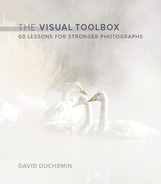Lesson 13. Isolation: Use a Longer Lens
Telephoto lenses, anything over a 35mm equivalent of 50–60mm, have the opposite effect of a wide angle, and the longer they get (200, 300, 600mm) the greater the difference. As telephoto lenses get longer in focal length, they have tighter and tighter angles of view and greater and greater magnification. They excel at pulling far things near, compressing elements, and really isolating—not just to get that great shot of a duck, but to set that duck (or tree, or child on a swing) against its context and exclude all else. Photography is as much about what we exclude from the frame as it is about what we include. Every element in the frame exerts some visual mass, a subject we’ll talk more about later, and the more elements exerting that pull on the eye, the less impact each of those elements has. Sometimes the best tool for achieving impact is isolation, and the shallow angle of view and illusion of compression that’s created by telephoto lenses creates a sense of isolation really well.
Nikon D800, 300mm, 1/400 @ f/11, ISO 800
This whooper swan was tightly photographed with a 300mm lens.
Nikon D3s, 200mm, 1/80 @ f/6.3, ISO 200
Only the longest lens I had with me, the far end of my 70-200mm zoom, would allow me to isolate the great lines on the roof of the Chateau Frontenac in Quebec City without other clutter spoiling the purity of the lines and colour in this image.
The other advantage of using a longer lens is that the depth of field at a given aperture appears much shallower than with a wider lens. In my humanitarian work I’ve often put a 200mm f/2.8 lens on my camera, and backed up a little, giving me a little more context, but still powerfully isolating my subject. Shallow depth of field and a tight angle of view make background control much easier.


